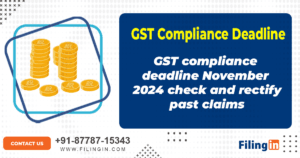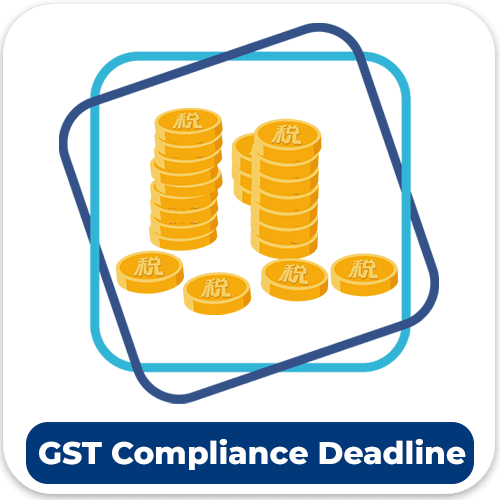In November, GST returns take on added importance as they require careful reconciliation to ensure full compliance. This month is a critical time for businesses to review their records, verify all transactions, and rectify any previous inaccuracies in their filings. Adhering to GST deadlines, especially in November, helps prevent missed tax credits and compliance issues, allowing for smoother financial management and peace of mind.

Why Is November Critical for GST Filing?
Each year, the month of November carries special significance in the Goods and Services Tax (GST) filing calendar. Section 16(4) of the Central Goods and Services Tax (CGST) Act emphasizes this month by setting a hard deadline for claiming Input Tax Credit (ITC) on invoices and debit notes. This deadline is structured to:
- Enforce compliance in a timely manner.
- Assist registered taxpayers in maximizing their tax benefits without error.
Under Section 16(4), a registered person must claim ITC by whichever comes first:
- The due date for filing the November return of the following financial year.
- The date for filing the annual return for that year.
This strict timeline demands heightened vigilance to avoid penalties or lost credits. Let’s break down why this deadline matters, how to address any errors, and the steps needed to rectify past claims.
Understanding Section 16(4) and Its Impact on ITC
Section 16(4) of the CGST Act plays a pivotal role in ITC management for businesses. The section outlines:
- The last allowable month for claiming ITC on invoices or debit notes.
- The emphasis on accuracy to avoid financial and legal consequences.
Filing ITC claims in November allows businesses to avoid compliance issues, potential penalties, and ensures that credits are received timely, making this a critical deadline for any registered GST filer.
How to Rectify Mistakes in FY 2023-24 Returns
Errors can slip in when filing GST returns, leading to incorrect claims or misreporting. Fortunately, corrections are possible for FY 2023-24, but these adjustments need to be done with precision.
Step 1: Reconcile Key GST Forms
The first step in error correction is reconciling essential GST forms, such as:
- GSTR-1: Record of all outward supplies.
- GSTR-2B: A static ITC statement for inward supplies.
- GSTR-3B: A monthly self-declared summary of GST liabilities.
Step 2: Review Last Year’s Returns
Identify any discrepancies by reviewing past returns to spot:
- Missed or incorrect outward supplies.
- Any wrongly claimed or unclaimed ITC.
Step 3: Make Adjustments in Current Year’s Returns
To correct FY 2023-24 errors, taxpayers can:
- Adjust in the current GSTR-3B return, ensuring alignment with previously filed records.
- Make necessary entries in the GSTR-1 for accuracy.
Note: Adjustments are permitted only in the October 2024 returns, filed on or before November 2024.
Best Practices for GST Compliance and Error Rectification
- Timely Reconciliation: Schedule routine checks to align records and avoid last-minute stress.
- Accurate Documentation: Keep all invoices, debit notes, and other relevant documents organized.
- Monitor ITC Closely: Avoid missing out on eligible credits by maintaining an updated ITC log.
- Seek Professional Help: Complexities in GST can sometimes demand expert guidance for error-free filing.
The Importance of GSTR-1, GSTR-2B, and GSTR-3B Forms in Error Management
Each of these forms plays a unique role in GST compliance, and understanding them is key to rectifying any past mistakes effectively.
- GSTR-1: Reflects your outward supplies and should be cross-checked to avoid overstatement or understatement.
- GSTR-2B: Provides a clear summary of ITC and helps in validating the inward supplies.
- GSTR-3B: Acts as a monthly summary and is the form where corrections and ITC adjustments are reflected.
Navigating GST compliance and rectifying past errors require attention to detail and timely action. By thoroughly reconciling returns and accurately managing ITC claims, businesses can avoid penalties and maximize their tax benefits. Staying vigilant in November, as mandated by Section 16(4), is crucial for every registered taxpayer.
{finish}
FAQs
- What is the deadline for ITC claims under Section 16(4)? The deadline is the earlier of the November return filing date of the next financial year or the annual return filing date.
- Can errors from FY 2023-24 be corrected? Yes, errors can be rectified in the October 2024 returns filed by November 2024.
- What happens if ITC is not claimed by November? Missing the November deadline means the ITC cannot be claimed, potentially leading to financial losses.
- Why is GSTR-2B important for ITC claims? GSTR-2B provides a static summary of eligible ITC, aiding in accurate ITC management.
- What are common mistakes in GST returns? Common errors include incorrect outward supply reporting, missed ITC claims, and wrong entries in GSTR-3B.

